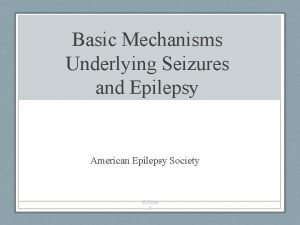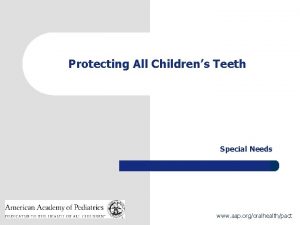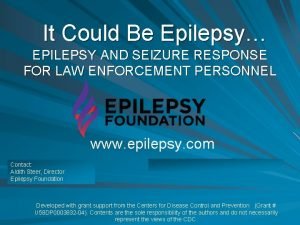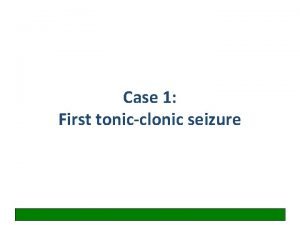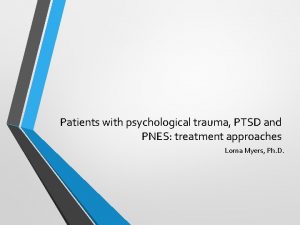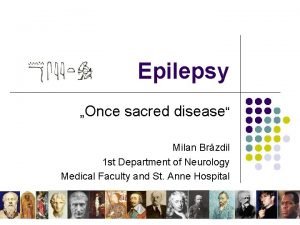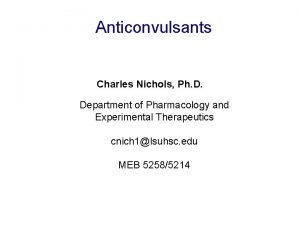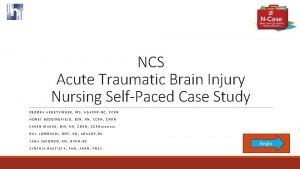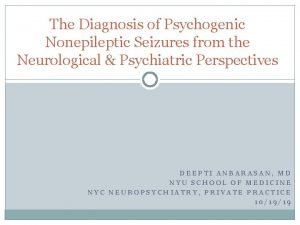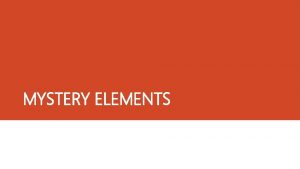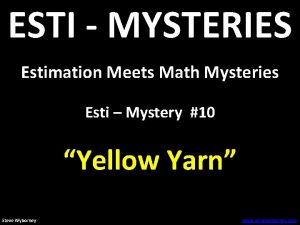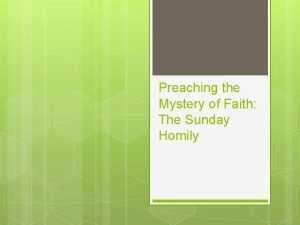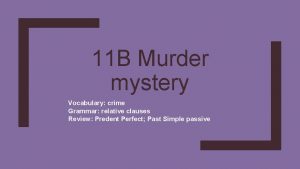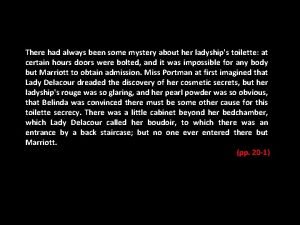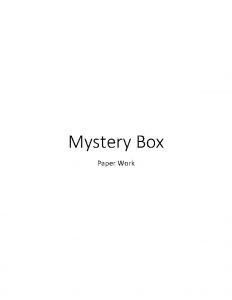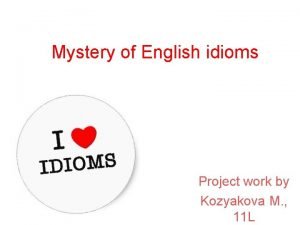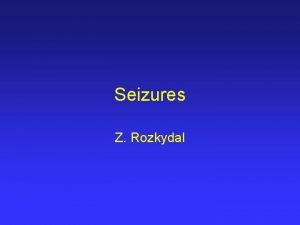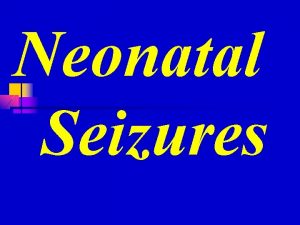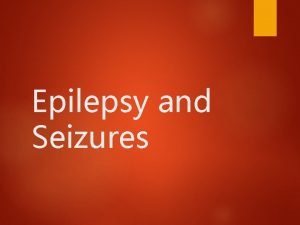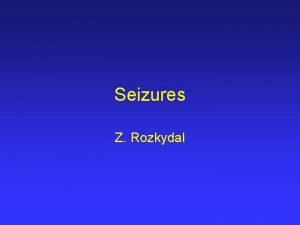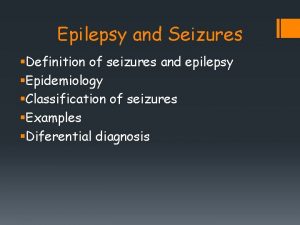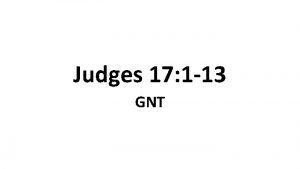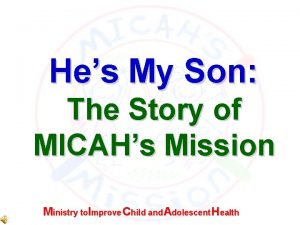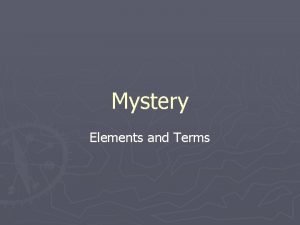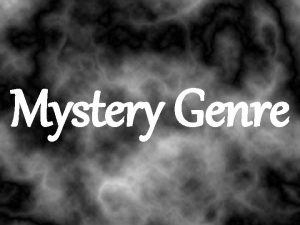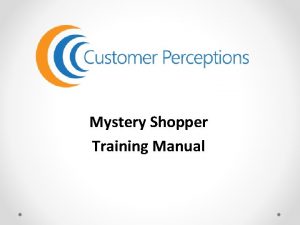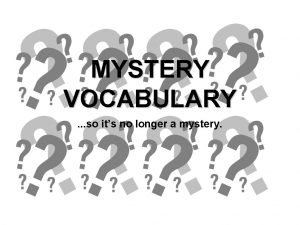Micahs Mystery A Case of Seizures in a




































- Slides: 36

Micah’s Mystery: A Case of Seizures in a Golden Retriever Ashley D. Justice

Meet Micah • 11 year old intact male Golden Retriever • Agility Champion • Presented to Auburn’s neurology service on 8/18/09 due to recent onset of seizure activity.

History • No previous history of seizures • No other medical conditions other than hypothyroidism. • First seizure activity on 6/13/09 • Transported to emergency clinic • Micah was placed on phenobarbital (63. 8 mg tablet BID)

History cont. • Micah was weaned off of the medication, then suffered another seizure a week later (8/9/09). • Controlled with rectal diazepam • Micah was placed back on the phenobarb • r. DVM tested for E. canis, Lyme disease, RMSF

Physical Examination • Bright, Alert, Responsive • Temperature, pulse, and respirations were all within normal limits. • No significant abnormalities found

Neurologic Examination • Mental status: normal • Gait and Posture: normal with the exception of a slightly abnormal rear limb gait • Slight, intermittent right head tilt was present, otherwise, all cranial nerves WNL • Spinal reflexes: WNL • Postural reactions: WNL

Seizures • Definition: the clinical manifestation of an excessive discharge of hyperexcitable cerebrocortical neurons. • Generalized, simple partial, or complex partial • Brief/isolated vs. Cluster • Micah: generalized

Pathophysiology • Imbalance between normal excitability and inhibitory mechanisms due to an intra or extra cranial disease process.

Seizure Classification • Primary epileptic seizures – 44%- no identifiable cause of seizure activity – Large breed dogs – 1 -5 yrs. (most initial episodes are from 6 mo. -3 yrs) – Longer inter-ictal period (>4 wks) – Generalized motor seizures – Considered familial or inherited

Seizure Classification • Secondary epileptic seizures – 46% - animal has an identifiable intracranial abnormality – Bimodal onset- <1 yr. or >7 yr. – Partial seizures included – First seizure is usually between midnight and 8 am. – Many etiologies

Seizure Classification • Reactive epileptic seizures – 10% – Metabolic, toxic, or other noxious insult capable of inducing seizures. – Most likely when inter-ictal period is <4 wks. – Most involve organ or endocrine disease. – All ages – Many etiologies

Initial Treatment • When to treat – >1 seizure in a 24 hour period – >1 seizure every 6 weeks – History of status or clusters – Judgement call • Goal: to reduce the seizure frequency to less than one single seizure every 6 -8 weeks ASAP. • Potassium Bromide and Phenobarbital are the most common treatment options.

KBr vs. Phenobarb • KBr - • Dosage: 40 -50 mg/kg q 24 (lower dose when used as an adjunct) • Contraindication: renal insufficiency • Ensure stable dietary chloride intake • Side effects: ataxia, lethargy, PU/PD • Phenobarb - • Dosage: 2. 5 -4 mg/kg q 12 – If seizures are occurring at intervals of less than 7 days, initiate PB therapy with an IV loading dose of 15 -25 mg/kg. – Measure levels in 2 wks. (target level is 20 -45 mcg/ml) • Contraindication: liver disease

Other considerations • Only if no seizures have occurred in 6 -12 months, consider slowly weaning over a period of a few months. • Do not administer drugs that interfere with the metabolism of PB: – Chloramphenicol, cimetidine, ranitidine, and tetracyclines. • Do not administer drugs which may lower the seizure threshold: – Ace, xylazine, ketamine, estrogens, tricyclic antidepressants, bronchodilators.

Initial Diagnostics • CBC, Serum chemistries, Urinalysis- no significant abnormalities. • 3 view thoracic radiographs- WNL • Titers for RMSF, E. canis, Neospora, Distemper, Toxoplasma- RMSF again mildly elevated, but likely represents previous exposure or exposure to a non-pathogenic strain. Distemper borderline increased, but probably not clinically significant. • Brain MRI

MRI results

2 7/14 4 12

Intracranial Tumors • Seizures could be the result of expansile growth or peri-tumoral effects (edema, compromised blood flow) • Rarely disseminate throughout the CNS by hematogenous or CSF routes. • Incidence: 14. 5 in 100, 000

Types of Intracranial Tumors • • • Astrocytic tumors Oligodendroglial tumors Ependymal cell tumors Mixed gliomas Tumors of the Meninges

Treatment Plan • Continue with the current drug regimen (phenobarb, saloxine) • Discharge (8/19/09) to return on 8/25/09 for brain surgery.

8/25/09 • Micah returns to Auburn for brain surgery • Bright, alert, and responsive with no seizure activity noted by owner.

Surgical Considerations • Intracranial pressure dynamics is the most important consideration for the patient prior to performing a craniotomy. • Monroe-Kellie Doctrine: the contents of the cranial vault are blood, CSF, and parenchymaan increase in any of these 3 results in a net decrease in the other 2 components.

Surgical Considerations (cont. ) • Pre-operative steroid administration – Dexamethasone: to reduce edema and CSF production – Sodium prednisolone succinate or methyl prednisolone succinate- antiinflammatory and tissue protective as oxygen free radical scavengers and stabilizers of the lysosomal membranes. – Micah: solu-delta cortef • Prophylactic antibiotic usage – To decrease CNS bacterial contamination – Micah: cefazolin

Craniectomy • Sternal recumbency • Transfrontal approach






Post-operative • Critical care • Monitoring: – – Check heart rate, respirations, and blood pressure every two hours. Flip sides every four hours, as well as ice pack incision every 4 hours. NPO LRS- 70 ml/hr • Medications: – – – – Cefazolin Lasix Buprenorphine Phenobarb Levothyroxine Midazolam Domitor Famotidine

Post-operative • Walked outside with assistance day 1 • NPO • Began offering food on day 2 and switched to oral antibiotic and pain control • Spiked a fever on day 3 but was controlled easily, received surgical histopathology results • Gradually increased food intake and walking distance

Meningioma • Most frequent CNS tumor seen in vet med • MST – Surgical excision followed by radiation therapy- 16 mo. – Surgical excision alone- 11 mo. – No treatment- variable – could be weeks to months. • • Breed predilection: dolicocephalic Age predilection: mature adults Behavior- generally benign Location: usually solitary – Cerebrum> cerebellum> spinal cord>ventricles

August 30, 2009 - Micah goes home!

Recheck-9/14/09 • BAR, incision healing nicely • Neurologic examination- inconsistent right eye menace response and droopy right eyelid • Owner reported Micah to be weak in his rear limbs • Pretreatment CT for radiation therapy

10/2/09 • Micah is receiving his 13 th of 16 fractions of radiation today. • He is doing great with no abnormalities thus far!

Thank You…. . • God • Family • Micah • Dr. Ortinau and Dr. Shores • Class of 2010 • Gran 1932 -2009 Phil. 4: 13 - “I can do all things through Christ who gives me strength. ”
 Basic mechanisms underlying seizures and epilepsy
Basic mechanisms underlying seizures and epilepsy Spina bifida occulta
Spina bifida occulta Pediatric seizures
Pediatric seizures Epilepsy symptoms
Epilepsy symptoms Psychomotor seizures
Psychomotor seizures Seizures
Seizures Ptsd seizures
Ptsd seizures Febrile convulsions
Febrile convulsions Psychomotor seizures
Psychomotor seizures Pimidone
Pimidone Seizures and tremors
Seizures and tremors What is a seizure
What is a seizure Simple partial seizures vs complex
Simple partial seizures vs complex Icp monitoring
Icp monitoring Psychogenic seizures
Psychogenic seizures Seizures
Seizures Best worst and average case
Best worst and average case Math mystery case of the graduation gremlins
Math mystery case of the graduation gremlins Bubble sort best case and worst case
Bubble sort best case and worst case Glennan building cwru
Glennan building cwru Bubble sort best case and worst case
Bubble sort best case and worst case Bubble sort algorithm pseudocode
Bubble sort algorithm pseudocode Ambiguous triangle case
Ambiguous triangle case Long case vs short case
Long case vs short case It project failure case study
It project failure case study Average case of binary search
Average case of binary search Elements of realistic fiction
Elements of realistic fiction Esti-mysteries 10
Esti-mysteries 10 Gloriousp mystery box
Gloriousp mystery box Preaching the mystery of faith
Preaching the mystery of faith Birthday mystery box
Birthday mystery box Predent perfect
Predent perfect Paschal mystery
Paschal mystery It had long been something of a mystery where and on what
It had long been something of a mystery where and on what Mystery box science lab
Mystery box science lab Quotes about paschal mystery
Quotes about paschal mystery Idioms about mystery
Idioms about mystery
